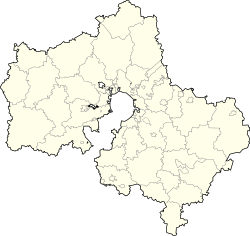Bronnitsy
Бронницы | |
|---|---|
| Coordinates: 55°25′34″N 38°15′54″E / 55.42611°N 38.26500°E | |
| Country | Russia |
| Federal subject | Moscow Oblast[1] |
| Known since | 1453[2] |
| Town status since | 1780s |
| Government | |
| • Mayor | Viktor Nevolin |
| Elevation | 120 m (390 ft) |
| Population | |
| • Total | 21,102 |
| • Subordinated to | Bronnitsy Town Under Oblast Jurisdiction[1] |
| • Capital of | Bronnitsy Town Under Oblast Jurisdiction[1] |
| • Urban okrug | Bronnitsy Urban Okrug[4] |
| • Capital of | Bronnitsy Urban Okrug[4] |
| Time zone | UTC+3 (MSK |
| Postal code(s)[6] | |
| Dialing code(s) | +7 49646 |
| OKTMO ID | 46705000001 |
| Website | bronnitsy |
Bronnitsy (Russian: Бро́нницы) is a town in Moscow Oblast, Russia, located 54.5 kilometers (33.9 mi) southeast of central Moscow and 13 kilometers (8.1 mi) west of the Bronnitsy station on the Moscow–Ryazan railroad. The town is surrounded by Ramensky District but is administratively incorporated as a town under oblast jurisdiction. Population: 21,831 (2021 Census).[7]
Local economy relies on food processing and packaging, construction services and jewellery manufacturing. Bronnitsy is listed among the twenty-two historical towns of Moscow Oblast.[8]
Existence of Bronnitsy is attested since 1453. The village emerged as a stopover station on the highway between Moscow and Ryazan (present-day M5 road), and its population and economy traditionally tended to horses. The House of Romanov stables, established in Bronnitsy by 1634, evolved into stud farms supplying riding horses to the cavalry. In the 1780s the administrative reform of Catherine the Great turned the village into a proper small town with a grid plan and a growing merchant community.[citation needed] In the second half of the 19th century Bronnitsy was gradually industrialized, becoming a town of small textile mills and jewelers.
Bronnitsy had a minor role in the military history of the Time of Troubles and Napoleon's invasion of Russia, when it became the farthest point of French advance after the fall of Moscow, but were spared from military action and destruction. Its key landmarks are the five-domed cathedral of Archangel Michael (completed in 1705), the church of Entry into Jerusalem (1845) and the neoclassical cavalry barracks.[9]
- ^ a b c d Cite error: The named reference
Ref1406was invoked but never defined (see the help page). - ^ Энциклопедия Города России. Moscow: Большая Российская Энциклопедия. 2003. p. 56. ISBN 978-5-7107-7399-4.
- ^ Russian Federal State Statistics Service (2011). Всероссийская перепись населения 2010 года. Том 1 [2010 All-Russian Population Census, vol. 1]. Всероссийская перепись населения 2010 года [2010 All-Russia Population Census] (in Russian). Federal State Statistics Service.
- ^ a b Cite error: The named reference
Ref773was invoked but never defined (see the help page). - ^ "Об исчислении времени". Официальный интернет-портал правовой информации (in Russian). June 3, 2011. Retrieved January 19, 2019.
- ^ Почта России. Информационно-вычислительный центр ОАСУ РПО. (Russian Post). Поиск объектов почтовой связи (Postal Objects Search) (in Russian)
- ^ Russian Federal State Statistics Service. Всероссийская перепись населения 2020 года. Том 1 [2020 All-Russian Population Census, vol. 1] (XLS) (in Russian). Federal State Statistics Service.
- ^ Cite error: The named reference
OHTwas invoked but never defined (see the help page). - ^ Cite error: The named reference
RHQwas invoked but never defined (see the help page).




